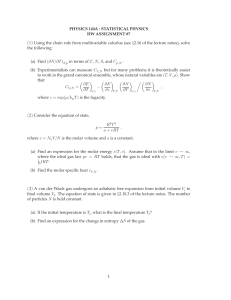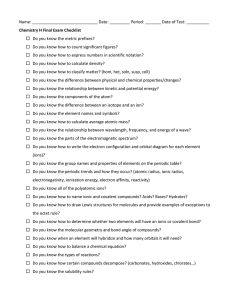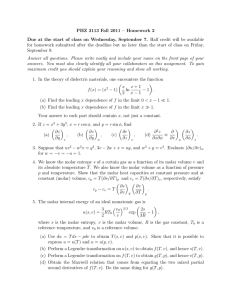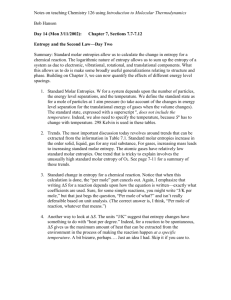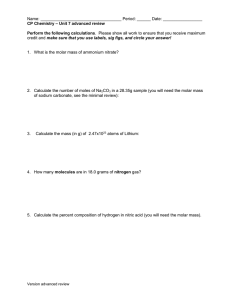Lecture 15 Gibbs Free Energy
advertisement
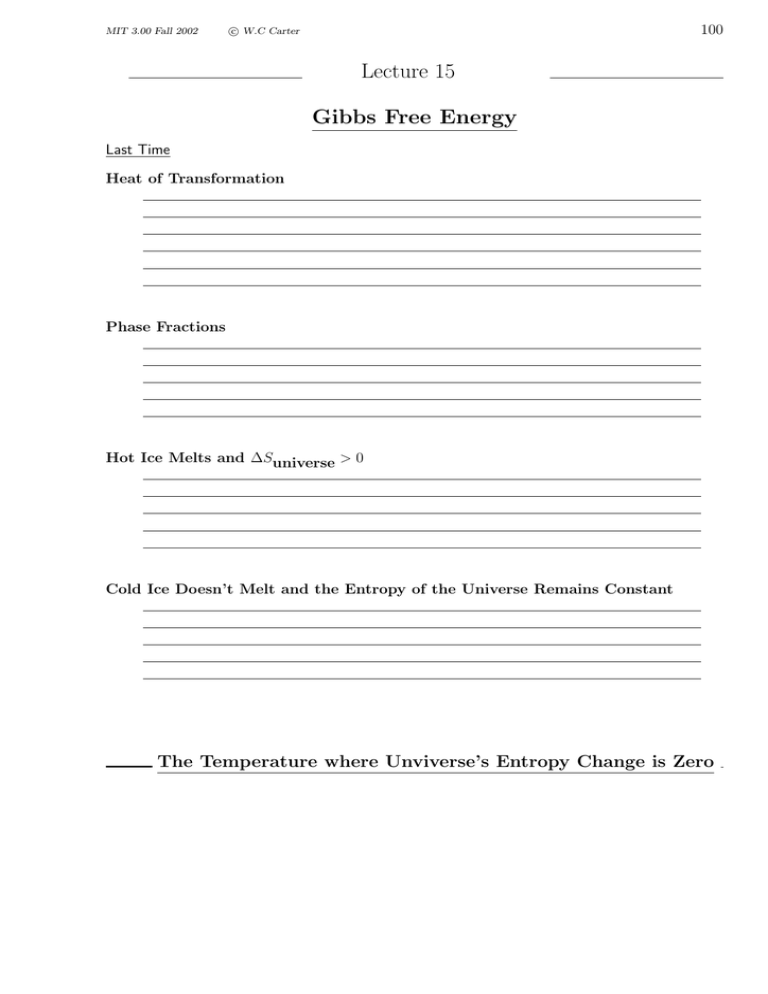
MIT 3.00 Fall 2002 100 c W.C Carter ° Lecture 15 Gibbs Free Energy Last Time Heat of Transformation Phase Fractions Hot Ice Melts and ∆Suniverse > 0 Cold Ice Doesn’t Melt and the Entropy of the Universe Remains Constant The Temperature where Unviverse’s Entropy Change is Zero MIT 3.00 Fall 2002 101 c W.C Carter ° reservoir at constant pressure P and temperature T reservoir at constant pressure P and temperature T heat of transformation Sinitial Hinitial Sfinal Hfinal Figure 15-1: Illustration of how the entropy of the universe was calculated for a phase transformation occurring for a body that is kept at constant pressure and temperature. At constant pressure, the heat of transformation is provided by the enthalpy change in the material undergoing a transformation. Application of the first and second laws results in an expression for the entropy change in the universe. Data for H2 O at 273◦ K and 1 atm Quantity Symbol Molar Enthalpy of Melting ∆Hmelt Molar Entropy of liquid H2 O SH2 O liquid Molar Entropy of solid H2 O SH2 O solid Molar Heat Capacity of liquid H2 O CP H2 O liquid Molar Heat Capacity of solid H2 O CP H2 O solid Data 6008 J mole 63.2 J ◦ mole K 41.0 J ◦ mole K 75.44 J ◦ mole K 38.0 J ◦ mole K The data showed that the entropy change in the universe was positive if: 1) the hightemperature phase (liquid) converted to the low-temperature phase (ice) below the equilibrium transition (freezing) temperature; or, 2) The low-temperature phase (ice) converted to the high-temperature phase (liquid) above the equilibrium transition (melting) temperature. Furthermore, the entropy change of the universe would be negative if ice melted below the melting temperature, or if water froze above the freezing temperature. Similar statements can be written down generally for any phase transformation: MIT 3.00 Fall 2002 102 c W.C Carter ° In fact, it only happens that ∆S universe = 0 for freezing and melting at only one temperature (at fixed pressure), and that is: Tmelt = Tfreeze = 273K for H2 Oat 1 atm pressure.. In fact, at that temperature H liquid − TS liquid =H solid − TS solid if T = Tmelt (15-1) and this reintroduces a new thermodynamic function. Because H was the available thermal energy at constant P (recall the argument that U +P V was subtracting of the available compressive energy), G ≡ H − TS (15-2) must be the related to the available energy after the “compressive” term and “thermal” term are removed. This new function must be the internal energy available to do “other kinds of work” at constant P , and T . G is called the Gibbs free energy. We can rewrite Equation 15-1 in terms of the new function: In fact this, MIT 3.00 Fall 2002 103 c W.C Carter ° will become our most favorite criteria for equilibrium at constant P and T . Note that there are several equivalent ways to write the Gibbs free energy in terms of the other thermodynamic functions that we have introduced. Some of the relations for the molar Gibbs free energy are: G = H − TS = F + PV = U − TS + PV (15-3) Note that if we had considered a phase change that takes place at constant volume: reservoir at constant temperature T heat of transformation Sinitial Uinitial reservoir at constant temperature T rigid constant volume subsystem Sfinal Ufinal Figure 15-2: Illustration of how to calculate change of entropy of the universe for a phase transformation occurring at fixed volume. This is an unusual case, because it would require something to contain the subsystem that was infinitely rigid. At constant volume, no P V work is done so all the the heat of transformation is provided by the internal energy change in the material undergoing a transformation. Application of the first and second laws results in an expression for the entropy change in the universe: T ∆Suniverse = −∆Fsubsys = −(∆Usubsys − T ∆Ssubsys ) MIT 3.00 Fall 2002 c W.C Carter ° 104 Summary of Equilibrium Conditions Special Condition Utility ∆Suniverse = 0 All cases Fundamental criterion for reversible process or equilibrium by the second law of thermodynamics. Must be applied to every possible subsystem affected by a process. ∆Gsystem = 0 System at constant P and T Fundamental criterion for reversible process or equilibrium for typical experimental conditions. Calculation need only consider the system undergoing change—but extra conditions, i.e., constant P and T must be assumed. ∆Fsystem = 0 System at constant V and T Fundamental criterion for reversible process or equilibrium for isothermal constant volume phase transition. This will not differ much from ∆G for systems that have a small ∆V associated with the transformation. Change Nature Prefers Low Enthalpies at Low T and Large Entropies at High T The behavior of G during a phase change. Consider how the molar Gibbs energy changes when ice melts: 105 c W.C Carter ° G (Molar Gibbs free energy) MIT 3.00 Fall 2002 G liquid P =constant G solid Teq T (Temperature) — G (molar Gibbs free energy) f (phase fraction) Figure 15-3: Plot of molar free energy of solid and liquid phases against temperature. The curve with the lowest value of G indicates which phase is most stable at that particular temperature. 1 0 f solid f liquid f liquid f solid ∆Hmelting — liquid G — solid G — solid G — liquid G H° H (molar enthalpy) Figure 15-4: Plot of phase fractions of the molar free energy of solid and liquid phases against enthalpy. The molar Gibb’s free energy of each phase is equal during the transformation regardless of how much material is present.
